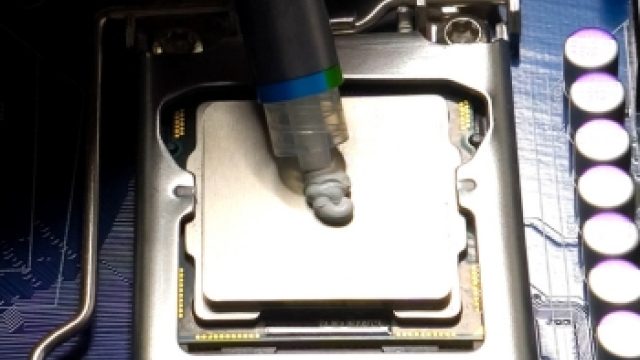Applying thermal paste to a CPU is a crucial step in building or maintaining a computer system. The proper application of thermal paste ensures efficient heat transfer between the CPU and the heatsink, preventing overheating and enhancing overall performance.
In this guide, we will explore the best practices for applying thermal paste on a CPU, ensuring that your processor operates at optimal temperatures and prolongs its lifespan. Mastering this process will contribute to a stable and reliable computing experience.
Understanding Thermal Paste
Thermal paste, also known as thermal compound or thermal grease, is a crucial component used in the cooling process of CPUs (Central Processing Units). Its primary purpose is to enhance the thermal conductivity between the CPU and the cooler, ensuring efficient heat transfer and preventing overheating.
There are various types of thermal pastes available, each with its unique composition and characteristics. Some common types include ceramic-based, metal-based, and carbon-based thermal pastes. Ceramic-based pastes are electrically non-conductive, ideal for avoiding short circuits. Metal-based pastes offer excellent thermal conductivity, while carbon-based pastes strike a balance between performance and electrical conductivity.
Selecting the appropriate thermal paste for your CPU is essential for optimal cooling performance. Factors such as thermal conductivity, electrical conductivity, longevity, and application method should be considered. Additionally, compatibility with your specific CPU socket and cooler is crucial to ensure a perfect fit.
Preparing for Application
Before applying thermal paste, gather the necessary tools and materials. You’ll need isopropyl alcohol, lint-free cloths, thermal paste, and your CPU cooler. Having these items ready ensures a smooth application process.
Properly cleaning the CPU and cooler surfaces is vital for effective heat transfer. Use isopropyl alcohol and a lint-free cloth to remove any existing thermal paste residue. Ensure both surfaces are free from dust, debris, and oils.
Avoid common mistakes like using excessive force during cleaning, which could damage the CPU or cooler. Also, refrain from using abrasive materials that might scratch the surfaces. Careful preparation sets the foundation for a successful thermal paste application.
Applying the Pea Method
The pea method is a popular and straightforward technique for applying thermal paste. Place a small pea-sized dot of paste at the center of the CPU. When the cooler is installed, the pressure will spread the paste evenly across the CPU surface.
To ensure an even spread, make sure the cooler is installed evenly and securely onto the CPU. Avoid moving the cooler around once it makes contact with the paste. Let the pressure work its magic in spreading the paste.
Visual aids, such as images or diagrams, can be immensely helpful in understanding the pea method. They provide a clear representation of how the thermal paste should be applied and how it spreads when the cooler is attached.
The Spreading Method: Pros and Cons
The spreading method involves manually spreading a thin layer of thermal paste over the CPU surface using a card or spatula. This technique offers more control over the paste application and is often preferred by some enthusiasts.
The spreading method allows precise application, ensuring complete coverage. However, it requires more effort and can lead to an uneven spread if not done carefully. Additionally, it might introduce air bubbles, affecting the overall cooling efficiency.
If you choose the spreading method, apply a thin, even layer of thermal paste, making sure there are no gaps or air pockets. Use gentle and controlled movements to achieve the best results.
Related Article: Thermal Paste Alternative: Debunking Myths and Risks
Thermal Paste Application for Different CPU Sockets
Different CPU sockets have unique designs, and their thermal paste application may vary. For Intel and AMD CPUs, be mindful of the location of the cores and ensure the paste adequately covers them.
Ensure the thermal paste you choose is compatible with your CPU socket type. Properly align the cooler during installation to avoid misalignment and uneven spread of the paste.
Addressing Common Application Mistakes
Using too much or too little thermal paste can hinder the cooling efficiency. Over-application can lead to excess paste oozing out, potentially causing electrical issues. Under-application might not provide sufficient heat transfer, leading to higher CPU temperatures.
Applying too much thermal paste can create a thicker-than-needed layer, hindering heat transfer. Conversely, using too little paste can leave gaps and air bubbles, reducing cooling performance.
If you encounter application issues, it’s best to start over. Remove the cooler, clean the surfaces, and reapply the thermal paste using the appropriate method. Double-check for any misalignments during reinstallation.
Reapplying Thermal Paste
Over time, thermal paste can degrade and lose its effectiveness. If you notice increased CPU temperatures, it might be time for a reapplication. Additionally, if you disassemble your CPU for maintenance or upgrades, reapplying thermal paste is necessary.
When reapplying thermal paste, follow the same cleaning process as during the initial application. Ensure both the CPU and cooler surfaces are thoroughly cleaned before adding a fresh layer of paste.
The frequency of thermal paste reapplication depends on various factors, such as the type of paste used, CPU usage, and ambient temperature. As a general rule of thumb, consider reapplying every one to two years for optimal cooling performance.
Related Article: What Happens When CPU Cooler Dies and How to Avoid It
Thermal Paste and CPU Cooling Performance
The thermal paste plays a vital role in dissipating heat from the CPU. A well-applied thermal paste ensures efficient heat transfer, leading to lower CPU temperatures and improved overall performance.
Numerous benchmarks and real-world tests have been conducted to compare the effects of different thermal pastes on CPU cooling. These comparisons help users make informed decisions when choosing the most suitable thermal paste for their needs.
For enthusiasts who overclock their CPUs, thermal paste becomes even more critical. Overclocking generates additional heat, and using a high-quality thermal paste is essential to maintain stable and safe operating temperatures.
Debunking Thermal Paste Myths
There are several myths and misconceptions surrounding thermal paste, such as the need for exotic application methods or the notion that more paste equals better cooling.
By dispelling these myths, users can focus on the correct application techniques and choose the right thermal paste to achieve optimal CPU cooling.
Thermal Paste Maintenance
Regularly monitoring CPU temperatures can help identify any potential issues with the thermal paste’s performance. Monitoring software and tools can provide insights into temperature trends.
If you notice a gradual increase in CPU temperatures over time, it may indicate thermal paste degradation. When the paste’s performance diminishes significantly, it’s time to replace it with a fresh application.
To extend the lifespan of thermal paste, ensure your CPU and cooler are well-maintained, and avoid exposing them to extreme temperature conditions.
Thermal Paste for Laptops and GPUs
Laptops and graphics cards also benefit from proper thermal paste application. The same principles apply, and using the right method is crucial for efficient cooling.
Due to the compact design of laptops and GPUs, the amount of thermal paste needed should be carefully adjusted. Additionally, the application method may vary slightly from desktop CPUs.
Applying thermal paste correctly can significantly improve a laptop’s cooling capabilities, leading to better performance and increased longevity.
Comparing Thermal Paste Brands and Products
Several reputable brands offer high-quality thermal pastes. Understanding the strengths and weaknesses of each brand can help users make an informed choice.
User reviews and expert recommendations can provide valuable insights into the real-world performance of different thermal paste products. Considering both can guide users in selecting the best option for their specific needs.
When choosing a thermal paste, consider factors like thermal conductivity, application method, compatibility with your CPU, and budget constraints. Each user’s requirements may differ, so finding the perfect fit is essential for achieving optimal CPU cooling.
FAQs About How To Apply Thermal Paste CPU
How should I put thermal paste on CPU?
To apply thermal paste on a CPU, first, clean the CPU and heatsink surfaces with isopropyl alcohol. Then, place a small pea-sized dot of paste on the center of the CPU. Gently press the heatsink onto the CPU and let it spread naturally.
Do you apply thermal paste directly to the CPU?
Yes, thermal paste should be applied directly to the CPU. It acts as a conductive medium, filling microscopic gaps between the CPU and heatsink, ensuring better heat transfer and preventing overheating.
Can you use the CPU right after applying thermal paste?
After applying thermal paste, it is recommended to reassemble your system immediately. The paste requires little to no curing time, so you can use the CPU right away.
How long does thermal paste last?
Thermal paste can last for several years if properly applied and maintained. However, its effectiveness may decrease over time, and it’s a good idea to reapply it every 3 to 5 years for optimal performance.
Does thermal paste expire?
Yes, thermal paste can expire. Most pastes come with an expiration date. Using expired paste may lead to decreased thermal conductivity and potential overheating issues.
Does thermal paste stop the CPU from overheating?
Thermal paste enhances heat transfer, helping to prevent CPU overheating. It fills gaps and ensures a smooth interface between the CPU and heatsink, facilitating better dissipation of heat.
Do you need to remove old thermal paste?
Yes, before applying new thermal paste, it is essential to remove the old one. Use isopropyl alcohol and a lint-free cloth or cotton swab to clean both the CPU and heatsink surfaces thoroughly.
Why is my CPU overheating?
CPU overheating can be caused by various factors, such as inadequate cooling, improper application of thermal paste, dust buildup in the heatsink, or a malfunctioning cooling system.
What is a normal temperature for CPU?
A normal temperature for a CPU varies depending on the model and load. Generally, idle temperatures can range from 30°C to 50°C, while under load, temperatures can reach 60°C to 85°C. It’s essential to monitor temperatures regularly to ensure they stay within safe limits.
Final Thoughts About How To Apply Thermal Paste CPU
Applying thermal paste on a CPU is a critical process that directly impacts its performance and longevity.
To achieve optimal results, ensure a clean and dust-free environment before beginning. Applying a small pea-sized amount at the center of the CPU and gently pressing the heatsink down will allow the paste to spread evenly.
Avoid excessive amounts as it may lead to poor heat transfer or spillage. Regularly check and replace thermal paste every few years to maintain efficient heat dissipation. By following these simple steps, you can ensure that your CPU operates at safe temperatures, maximizing its potential and extending its lifespan.


